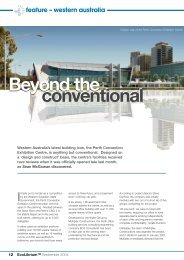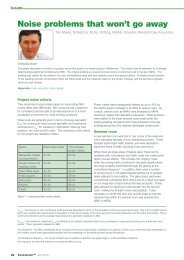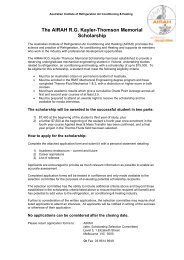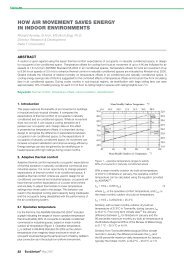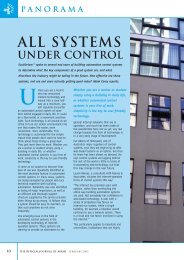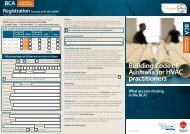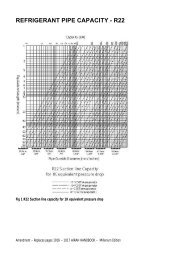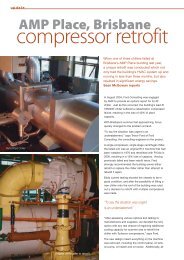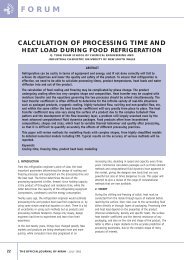Thermal Bridging Chart - Australian Institute of Refrigeration Air ...
Thermal Bridging Chart - Australian Institute of Refrigeration Air ...
Thermal Bridging Chart - Australian Institute of Refrigeration Air ...
Create successful ePaper yourself
Turn your PDF publications into a flip-book with our unique Google optimized e-Paper software.
FORUM<br />
cont. from page 23<br />
This method should not be restricted to air handling units. It may be<br />
applied to any components that require control <strong>of</strong> thermal bridging<br />
properties, e.g. air conditioning duct work.<br />
Generally it can be used in the following way:<br />
• Determine k b value <strong>of</strong> the component concerned either theoretically<br />
or experimentally or both (refer to section 6 below).<br />
• Plot the component onto the chart.<br />
• Plot also the criteria due point (either given in specifications or<br />
extracted from handbooks)<br />
• The chart would then clearly show 1) if the component is well above<br />
the due points, meaning no condensation; 2) which TB zone the<br />
component is in.<br />
• Repeat the above for other components <strong>of</strong> the structure concerned.<br />
All components can be plotted on one chart, providing a better<br />
comparison.<br />
6. DETERMINING k b<br />
As mentioned above the k b value <strong>of</strong> components can be obtained from<br />
either theoretical calculation or experimental measurement. Theoretical<br />
determination <strong>of</strong> k b varies depending on the complexity <strong>of</strong> the<br />
component and the way it is modeled. This will be dealt with elsewhere.<br />
To measure the k b value <strong>of</strong> a component we need to create a<br />
temperature difference between the inside and out side air. Knowing<br />
that k b is independent <strong>of</strong> temperature and the temperature difference<br />
can be as low as 12k without compromising the measurement accuracy<br />
(refer to section 3 above), we can use either heating or cooling to<br />
achieve these temperatures. In the laboratory a box <strong>of</strong> ice or a heater<br />
with a suitable circulating fan can be placed inside the unit casing<br />
being tested. For installed units the temperature difference is normally<br />
readily available when the unit is running.<br />
Once the temperature difference is established and becomes stable, the<br />
inside temperature, outside temperature and the temperature on the<br />
surface <strong>of</strong> components can be measured and recorded. Equation 2 can<br />
then be applied to calculate the k b value for each component.<br />
7. DISCUSSIONS<br />
The above method provides a useful tool that quantifies the thermal<br />
bridging property <strong>of</strong> components and evaluates it against surface<br />
condensation. Through a large number <strong>of</strong> measurements, both in our<br />
laboratory and from installed units, we found that a satisfactory<br />
accuracy can be achieved with a lower temperature difference than that<br />
required by BS EN 1886. However we did maintain a minimum<br />
temperature difference <strong>of</strong> 12k.<br />
The accuracy <strong>of</strong> measurement can also be affected by the movement <strong>of</strong><br />
air, as this alters the thermal property <strong>of</strong> the surface layer <strong>of</strong> air. Care<br />
should therefore be taken when the unit being measured is either<br />
installed externally or in a plant room where air is moving through the<br />
room. In our laboratory testing we managed to maintain an inside<br />
surface air velocity similar to that found in a running air handling unit.<br />
The outside air was kept as still as possible.<br />
It is necessary to standardise the conditions <strong>of</strong> measurement so that the<br />
results are comparable and to a satisfactory accuracy. This should be<br />
considered in the development <strong>of</strong> the <strong>Australian</strong> version <strong>of</strong> the standard.<br />
8. CONCLUSIONS<br />
Based on both our theoretical analysis and experimental verification,<br />
the following conclusions can be made:<br />
(1) The concept <strong>of</strong> the thermal bridging factor k b introduced in BS EN<br />
1886:1998 is appropriate for measuring thermal bridging property <strong>of</strong><br />
air handling unit casing components.<br />
(2) It is appropriate to associate the k b factor to individual components<br />
<strong>of</strong> an air handling unit. This allows the designers to map the<br />
thermal bridging property <strong>of</strong> a unit in order to control, improve and<br />
balance the property among components. For the users it means<br />
better understanding and therefore higher confidence.<br />
(3) The temperature difference <strong>of</strong> 20k required by BS EN 1886:1998 for<br />
measurement <strong>of</strong> k b can be reduced to 12k with a satisfactory<br />
accuracy.<br />
(4) There is no difference in setting the inside temperature higher or<br />
lower than the outside temperature when measuring k b<br />
(5) <strong>Air</strong> movement affects the k b measurement and therefore needs to be<br />
controlled in a consistent manner when measuring k b.<br />
(6) The thermal bridging chart provides an accurate and yet easy-to-use<br />
method for mapping the thermal bridging property <strong>of</strong> components<br />
and determining surface condensation.<br />
(7) Further standardisation is necessary to adapt the concept and<br />
define test conditions for the <strong>Australian</strong> applications.<br />
About the Author<br />
Gang Wei is the Mechanical and Development Engineer/QA manager for<br />
<strong>Air</strong> Design Pty Ltd (Supplier <strong>of</strong> air handling units and air movement<br />
equipment).<br />
His responsibilities include new product development, engineering<br />
design, applications engineering, testing, as well as maintaining the<br />
quality system.<br />
Reference<br />
1. BS EN 1886:1998 Ventilation for buildings- <strong>Air</strong> handling units -<br />
Mechanical performance.<br />
2. The <strong>Australian</strong> <strong>Institute</strong> <strong>of</strong> <strong>Refrigeration</strong> <strong>Air</strong> Conditioning and Heating<br />
(inc.) Hand Book, 2nd Ed 1995<br />
3. Jones W. P. <strong>Air</strong> Conditioning Engineering, 4th Ed. Arnold 1994<br />
4. Haines R.W. and Wilson C.L. HVAC System Design Handbook, 2nd Ed<br />
MacGraw-Hill 1994<br />
5. Grimm N.R. and Rosaler R.C. Handbook <strong>of</strong> HVAC Design, MacGraw-<br />
Hill 1990<br />
AIRAH<br />
engineering a bEtter built environment<br />
FORUM<br />
JOIN AIRAH<br />
Call Joanna Roch at the National Office on (03) 9614 8868. Or simply fill in the<br />
form below and send it back to us by fax (03) 9614 8949 or mail to AIRAH,<br />
7/1 Elizabeth Street, Melbourne, VIC, 3000. Alternatively email your contact<br />
details to membership@airah.org.au<br />
AND RECEIVE<br />
• AIRAH handbook<br />
• AIRAH monthly journal<br />
• Industry Accreditation<br />
• State/territory activities<br />
• Networking<br />
• Member discounts on<br />
technical publications and<br />
industry training courses<br />
• Special Interest groups<br />
YES, I am interested in enjoying the benefits <strong>of</strong> AIRAH membership.<br />
Please contact me with more information.<br />
Name: ......................................................Position: ....................................<br />
Company Name:............................................................................................<br />
Address: ......................................................................................................<br />
................................................................State ..........Postcode ..................<br />
B/h Phone: ................................................Mob: ..........................................<br />
Email: ........................................................................................................<br />
24 THE OFFICIAL JOURNAL OF AIRAH<br />
THE OFFICIAL JOURNAL OF AIRAH<br />
✃<br />
25



